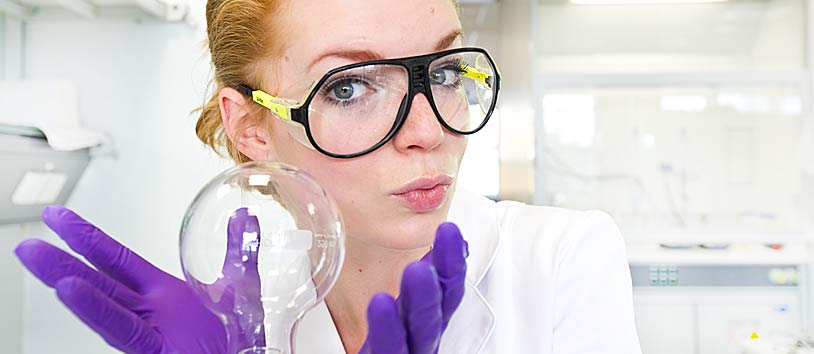- Peroxymonosulfuric acid is frequently used for cleaning heavily contaminated frit glass. It is generated from hydrogen peroxide and sulfuric acid which leads to a strong development of heat.
The actual danger however lurks elsewhere. Other attempts to clean are usually made beforehand – acetone is frequently used. Caro’s acid and organic solvents react strongly with one another which can result in serious explosions! - The good cleaning performance of the peroxymonosulfuric acid is a result of its strong oxidising effect. Cleaning agents which have active chlorine have a similar effect. These are clearly less hazardous and also explicitly intended for cleaning!
- The combination of nitric acid and hydrochloric acid ensures the aggressive oxidation force of the aqua regia through the formation of nitrosyl chloride and nascent chlorine. Therefore it is able to dissolve gold, palladium, ruthenium and even platinum!
- Solvent waste is burnt for disposal purposes. In order to prevent halogen hydrogen gases being released into the atmosphere on incineration, flue gas scrubbing occurs for halogen-containing solvents. This procedure is not necessary for halogen-free solvents.
- Accordingly it is less serious if halogen-free waste finds its way into the disposal canister for halogen-containing solvent residue. The opposite must be avoided at all costs as halogen hydrogen gases are released on incineration in this case.
- As soon as halogen-containing components are present in the solvent mix, it must be treated as halogen-containing waste – regardless of how small the proportion of halogen is.
- If solvent residues cannot be clearly classified, it is better to keep them in the disposal container for waste containing halogen!
- Standing water can contaminate and thus cause a risk to hygiene!
- Volumetric glassware is cleaned in special, small cleaning machines or in cleaning and disinfecting machines with a suitable module injector for pipettes. The pipettes are dried in the cleaning machines at up to 130 °C. Hot air drying ordinarily takes place at 110 °C for machine drying in the cleaning and disinfecting machine.
- Here it must be taken into account that various glass types are used for the manufacture of volumetric glassware. Soda lime glass is used as well as borosilicate glass 3.3. The low hydrolytic class of soda lime glass (class 3 compared with class 1 for borosilicate glass 3.3 according to ISO 719) means that a particularly gentle cleaning programme has to be used for this type of glass. Therefore the temperature, the reaction time, the strength of alkaline cleaners and the pH value should be kept as low as possible, as the glass is attacked more strongly with these types of glass which leads to glass corrosion. Glass corrosion results in the surface being attacked which leads to a limited transparency.
- There are special cleaning baskets for the cleaning of slides which can be used for automated cleaning. This means that the slides are cleaned safely, gently and effectively. Cover plates are used once and then disposed of after use.
- Depending on the type of stickers, special cleaning agents and high temperatures allow stickers to be removed more easily. Once the machine programme has ended, any remains of stickers which may still be adhered should be removed from the cleaned item while it is still warm. The strainer must also have the sticky residue removed to avoid hardening when the cleaned item cools down and the sticky residues can no longer be removed easily.
- The cleaning agents used should not contain any phosphates so that the phosphate analysis of the water samples is not distorted!
- The cleaning agents used should not contain any phosphates so that the phosphate analysis of the water samples is not distorted!
- When cleaning it is necessary to choose a suitable cleaning process in line with the type of glass and the resultant chemical and thermal resistances. The low hydrolytic class of soda lime glass (class 3 compared with class 1 for borosilicate glass 3.3 according to ISO 719) means that a particularly gentle cleaning programme has to be used for this type of glass.
- Please take into account the fact that the disposal suggestions shown here cannot be seen as universally valid as disposal arrangements may vary depending on the installations and institutions. The suggestions are given to the best of our knowledge and they are not guaranteed.

